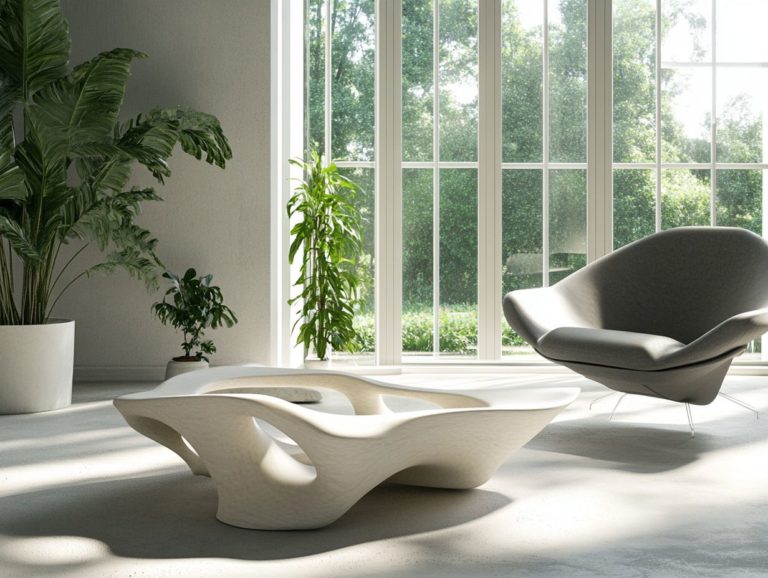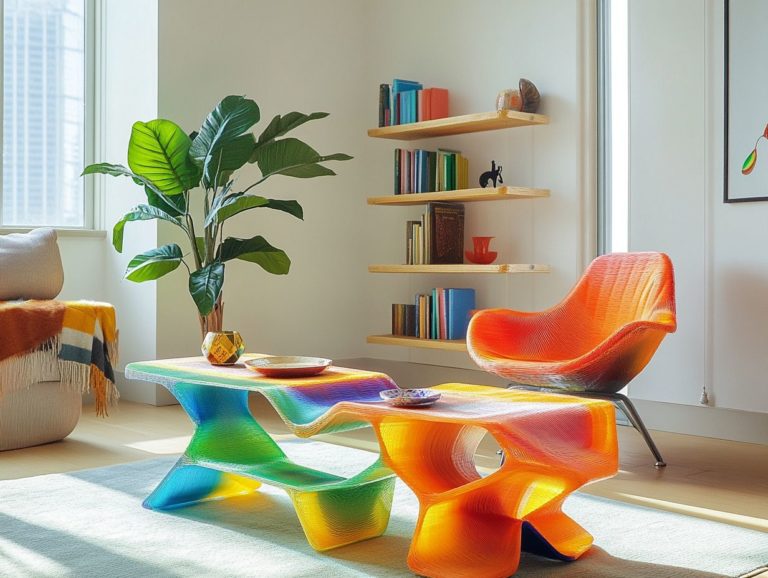How to Care for Your 3D-Printed Furniture
3D printing has revolutionized the way you create and interact with furniture, providing a level of customization and design flexibility that traditional methods simply can’t offer.
Let s explore the exciting advantages of 3D-printed furniture, highlighting aspects like cost-effectiveness and bespoke designs tailored to your unique preferences.
You ll also find essential care tips, covering cleaning, maintenance, and storage strategies to ensure longevity.
Ready to keep your 3D-printed pieces looking their best? This guide is for you!
Contents
- Key Takeaways:
- Benefits of 3D-Printed Furniture
- Caring for Your 3D-Printed Furniture
- Long-Term Care and Storage
- Repairing and Restoring 3D-Printed Furniture
- Professional Restoration Options
- Frequently Asked Questions
- 1. How do I clean my 3D-printed furniture?
- 2. Is it safe to use water on 3D-printed furniture?
- 3. Can I use furniture polish on 3D-printed furniture?
- 4. How do I protect my 3D-printed furniture from UV rays?
- 5. What should I do if my 3D-printed furniture gets scratched?
- 6. How do I store my 3D-printed furniture?
Key Takeaways:
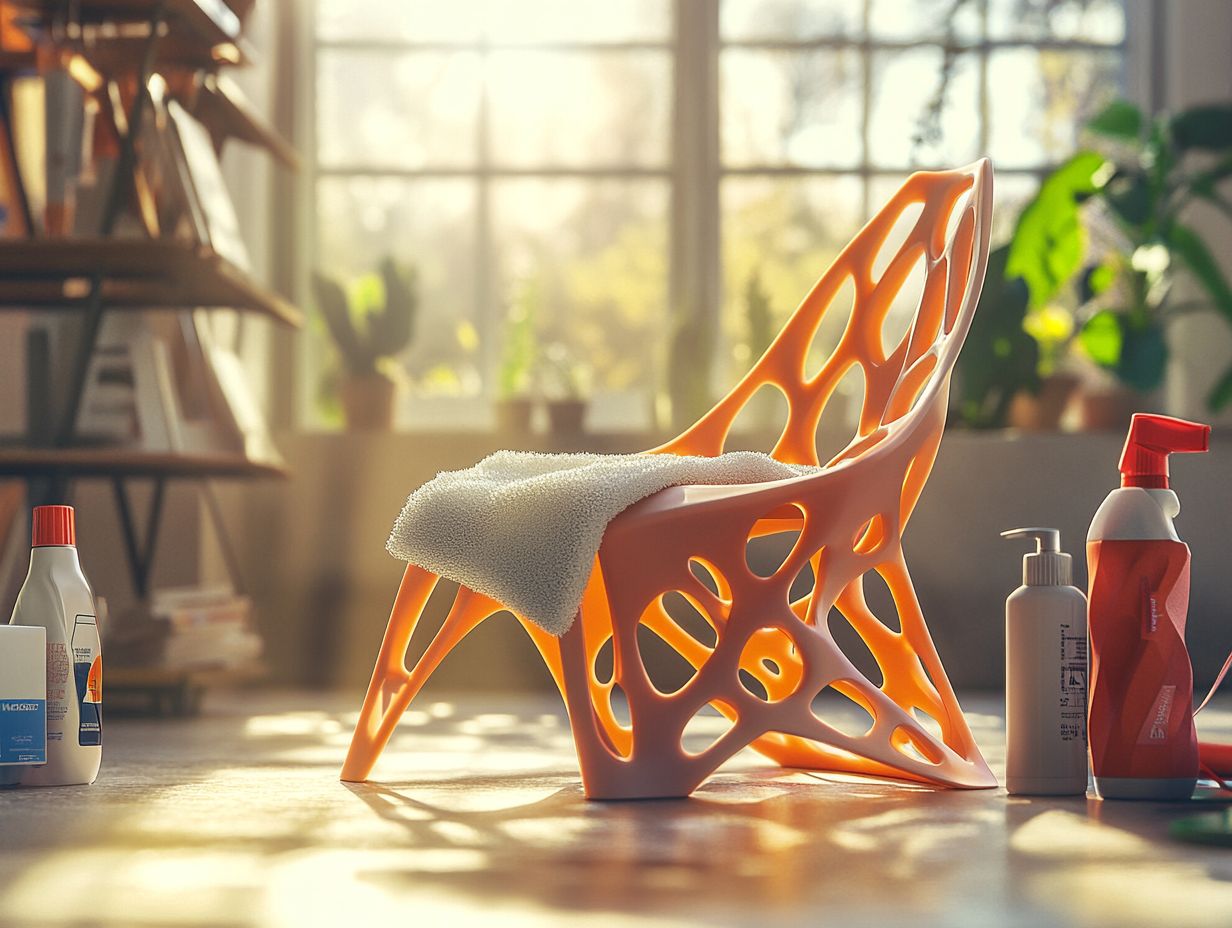
- 3D-printed furniture offers unique customization and design flexibility for a personalized touch to your home decor.
- Proper cleaning and maintenance, as well as protection against damage, can help extend the lifespan of your 3D-printed furniture.
- Long-term care, storage, repairing, and restoring options can ensure your 3D-printed furniture stays in good condition for years to come.
What is 3D Printing and How Does it Work?
3D printing, often referred to as additive manufacturing, lets you create stunning three-dimensional objects from digital files through a meticulous layer-by-layer process. This remarkable technology employs various techniques, including Fused Deposition Modeling (FDM) (a method where melted plastic is layered to form objects) and Stereolithography (SLA) (which uses a laser to solidify liquid resin). These methods allow you to produce intricate designs using a diverse range of filament types like PLA (a biodegradable plastic), ABS (a durable plastic), and Nylon (known for its strength and flexibility).
With 3D printing at your fingertips, you can bring your creative visions to life with astonishing precision, making it an invaluable asset across numerous industries and personal projects.
FDM works by melting thermoplastic filament and extruding it through a nozzle, while SLA utilizes a laser to cure liquid resin into solid layers each method tailored to meet specific needs. If you’re seeking durability, PETG (a strong and impact-resistant plastic) filaments are a fantastic choice, whereas specialty materials like carbon fiber-infused filaments can significantly enhance strength.
The versatility of 3D printing knows no bounds; it’s transforming fields such as healthcare (where prototypes and custom implants are meticulously crafted), and the automotive industry (where lightweight components are engineered for optimal performance).
However, maintaining print quality is paramount; any inconsistencies can compromise functionality and aesthetics. This underscores the importance of proper calibration and careful material selection in your 3D printing endeavors.
Benefits of 3D-Printed Furniture
3D-printed furniture presents an array of advantages that elevate it to a premium choice for both discerning homeowners and sophisticated commercial spaces. The remarkable level of customization allows you to craft intricate designs tailored precisely to your needs, enhancing not only the aesthetic appeal but also promoting sustainability by minimizing material waste.
In an era where environmental consciousness is paramount, this innovative approach stands out as both an elegant and responsible investment.
Customization and Design Flexibility
The customization and design flexibility of 3D printing empower you to create unique furniture pieces that align perfectly with your individual tastes and space requirements. You can showcase intricate details that traditional manufacturing simply can’t replicate.
This technology allows you, as a designer or model builder, to experiment with shapes, sizes, and functionalities, enhancing both usability and aesthetics.
With the ability to tailor supports precisely and make optimal use of the print bed, you can craft complex geometries that are not only visually captivating but also structurally sound.
Imagine a beautifully articulated chair with customizable contours that adapt seamlessly to your body, ensuring maximum comfort. Or think about shelving units designed specifically to fit into those unconventional spaces in your home, maximizing every nook.
The intricate details made possible by 3D printing, like organic patterns or multi-functional components, can elevate ordinary furniture into statement pieces that reflect your personal style while being fully practical.
Dive into the world of 3D-printed furniture today and transform your space uniquely!
Cost Effectiveness
Cost-effectiveness is a major advantage of 3D-printed furniture. This process reduces material waste and production time, ultimately lowering overall expenses for consumers and business owners.
By harnessing digital modeling and precise manufacturing techniques, companies can cut labor costs while maximizing resource efficiency in furniture production.
This efficiency doesn t just streamline the crafting process; it also enhances equipment safety. With greater reliance on automated systems, the likelihood of human error diminishes, reducing risks commonly associated with traditional methods.
By using innovative materials specifically designed for 3D printing, you can significantly decrease material costs, sidestepping the excess that often plagues conventional production. For example, when furniture makers use thermoplastics (a type of plastic that becomes moldable when heated), they minimize their environmental footprint and achieve savings on raw material expenses.
The straightforward design process of 3D printing makes adhesive removal easier, cutting down cleanup time and related costs. This exciting technology is transforming the furniture industry from a cost-saving viewpoint, paving the way for a more sustainable and cost-effective future.
Caring for Your 3D-Printed Furniture
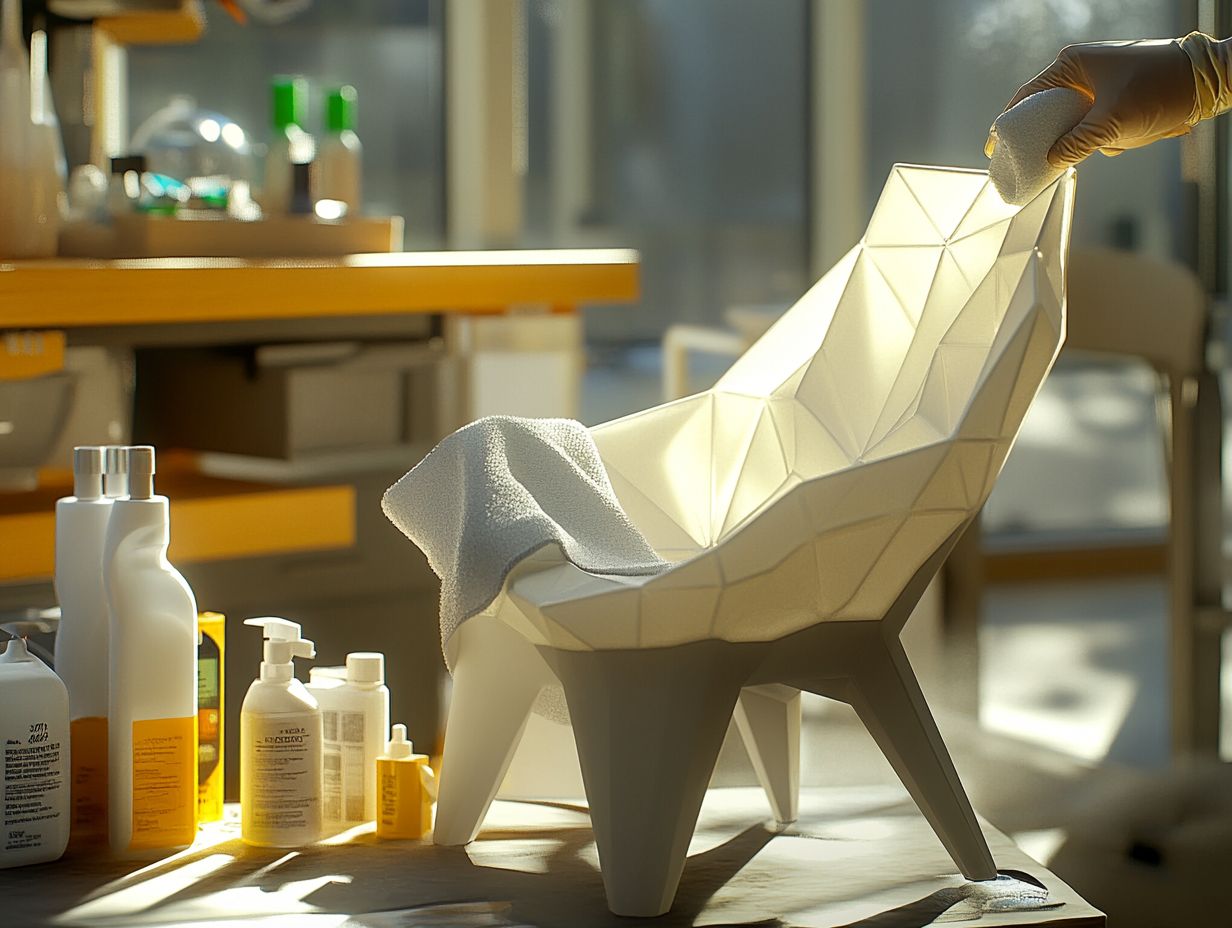
Caring for your 3D-printed furniture is crucial for preserving both its aesthetic charm and structural integrity. This involves following specific cleaning procedures and maintenance tips tailored to the materials used in its fabrication, as outlined in our guide on how to decorate with 3D-printed furniture.
By investing time in proper care, you ensure the longevity and usability of your unique pieces, allowing you to enjoy them for years to come.
Cleaning and Maintenance Tips
Effective cleaning and maintenance of your 3D-printed furniture hinge on a few key practices. Regular dust removal and surface polishing are vital. Use cleaning agents that suit the material, whether it s PLA or ABS, to enhance durability and aesthetic appeal.
To care for each type of filament properly, adopt specific cleaning procedures. For example, when dealing with PLA furniture, a gentle wipe using a microfiber cloth and mild detergent will suffice. ABS may require a touch of isopropyl alcohol to eliminate fingerprints and grime.
Incorporating polishing paper can work wonders in restoring scratches, especially on glossy finishes. If a surface needs extra attention, rotary sanding can provide the smooth finish it craves.
Regular maintenance not only preserves appearance but also ensures functional longevity, which is crucial for maintaining optimal print quality.
Protecting Against Damage
Protecting your 3D-printed furniture involves preventive measures and regular cleaning. Understanding your material’s weaknesses helps you choose effective strategies, including the best practices for designing 3D-printed furniture, whether that means applying a clear coat or regularly inspecting for wear and tear.
If you’re a Zortrax user, prioritize a clear coat application. This enhances shine and serves as a shield against UV light and moisture, preventing fading and warping over time.
Regularly inspect your furniture for scratches or cracks; catching potential issues early can save you from bigger headaches down the line. Don t overlook extruder care; debris or buildup can compromise print quality, ultimately affecting the durability of your furniture.
By taking these proactive steps, you create an environment where your 3D-printed pieces retain their beauty and structural integrity for years to come.
Long-Term Care and Storage
The long-term care and storage of your 3D-printed furniture are essential for preserving quality and functionality. For tips on maintaining these pieces, check out how to style your space with 3D-printed furniture to ensure they remain usable for years to come.
Implement effective storage techniques, such as keeping them out of direct sunlight and maintaining controlled humidity levels. This can significantly enhance the lifespan of your 3D-printed creations.
Proper Storage Techniques
Proper storage techniques are vital for maintaining the integrity of your 3D-printed furniture. For tips on incorporating these pieces into your home, check out this guide on mixing 3D-printed furniture with traditional decor. Avoid direct sunlight exposure to prevent warping or fading of materials over time.
To maximize the lifespan of your items, store them in a climate-controlled environment. Keep the temperature stable, ideally between 60 F and 75 F, while maintaining humidity levels below 50%.
Using Kapton tape on the edges helps prevent dust accumulation and scratches. A clear coat finish adds protection against UV rays and minor wear. Soft, breathable covers or shaded storage will also help safeguard your creations.
Handling and Moving Your Furniture
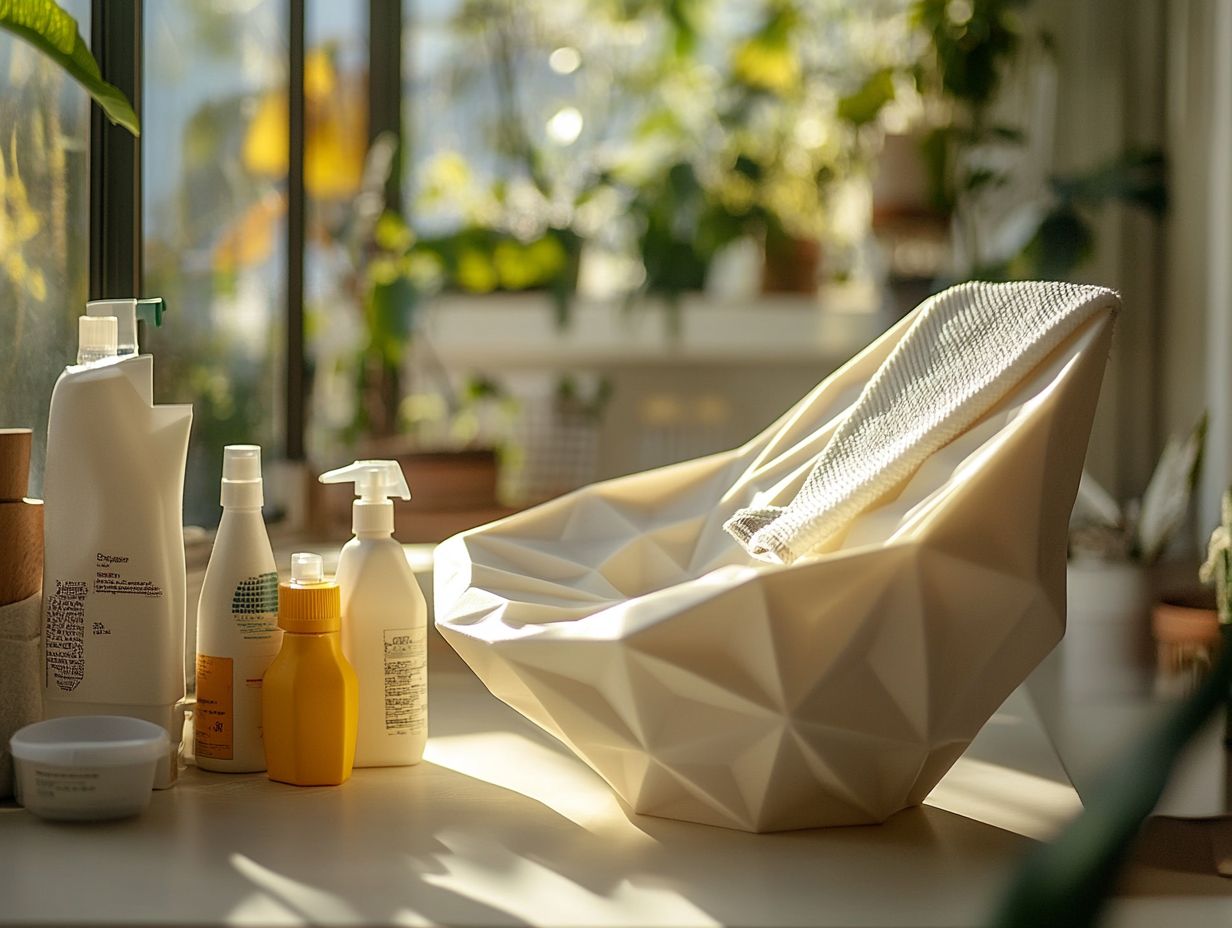
When handling and moving your 3D-printed furniture, use safety equipment and follow best practices to prevent damage during transportation. For more guidance, refer to this how to choose the right 3D-printed furniture for your home. Proper lifting techniques and protective wrapping will safeguard intricate designs.
Use a cleaning fan to remove dust and debris before moving. Always wear gloves to keep natural oils from your hands off the surface, especially if your items have a textured finish.
A rotary tool can help make adjustments and enhance stability during assembly. When lifting, bend at your knees and keep the load close to your body. This reduces strain on your back and protects your furniture from jolts.
Repairing and Restoring 3D-Printed Furniture
Repairing and restoring 3D-printed furniture involves tackling common issues like cracks, surface imperfections, and structural weaknesses. Understanding the process of creating 3D-printed furniture can help you use the right techniques and materials to breathe new life into your pieces.
By understanding these challenges, you enhance the longevity and usability of your furniture, ensuring it remains a cherished part of your space.
Common Issues and How to Fix Them
Common issues with 3D-printed furniture, such as material deformation and bonding failures, can often be fixed with simple maintenance tips. For more insights on this topic, check out how to incorporate 3D-printed furniture in your decor. Regularly clean your printer and conduct inspections to prevent these problems.
To enhance the longevity and quality of your creations, adopt effective dust removal practices and prioritize safety during printing. Keeping your environment free from dust and debris can elevate the quality of your final product.
Taking preventive measures, like regularly calibrating your printer and using the right materials, reduces the likelihood of material issues.
By cultivating a vigilant mindset and proactive approach, you can enjoy smoother printing experiences and create higher-quality furniture pieces that stand out. If you’re looking for inspiration, check out this guide on how to incorporate 3D-printed furniture in small spaces. What techniques will you try to protect your 3D-printed furniture today?
Professional Restoration Options
For those looking to preserve intricate details, professional restoration options are at your fingertips.
These specialists excel in repairing and enhancing unique pieces. They utilize expertise in various materials and techniques to ensure your furniture looks as good as new.
When you work with restoration specialists, you’ll experience careful cleaning and a detailed damage assessment. A protective coating seals the surface, giving your furniture a vibrant finish.
Investing in professional restoration is often worthwhile. It significantly enhances the appearance and longevity of your beloved pieces.
Frequently Asked Questions
1. How do I clean my 3D-printed furniture?
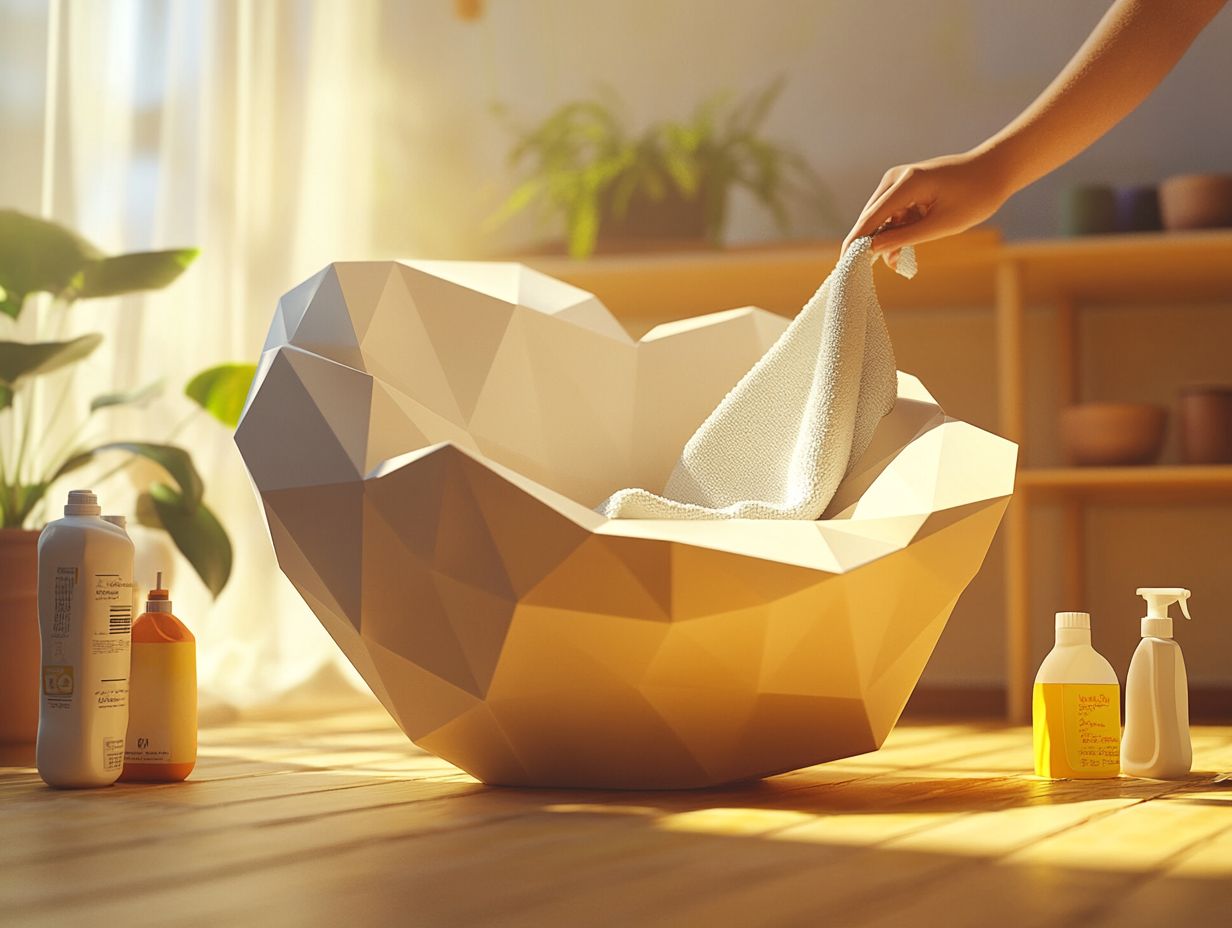
Use a mild soap solution and a soft cloth to clean your 3D-printed furniture. To ensure longevity, consider the best materials for 3D-printed furniture and avoid harsh chemicals or abrasive materials that may damage the surface.
2. Is it safe to use water on 3D-printed furniture?
Yes, using water is safe. Just make sure to dry it completely to prevent warping.
3. Can I use furniture polish on 3D-printed furniture?
No, furniture polish can discolor or damage the surface. Stick with mild soap for cleaning.
4. How do I protect my 3D-printed furniture from UV rays?
Direct sunlight can cause fading. Keep your furniture in a shaded area or apply a protective coating.
5. What should I do if my 3D-printed furniture gets scratched?
If scratched, use fine-grit sandpaper to gently sand the area. Apply a light touch to avoid further damage.
6. How do I store my 3D-printed furniture?
Store it in a cool, dry place away from sunlight. Cover it with a cloth or sheet to prevent dust buildup.



